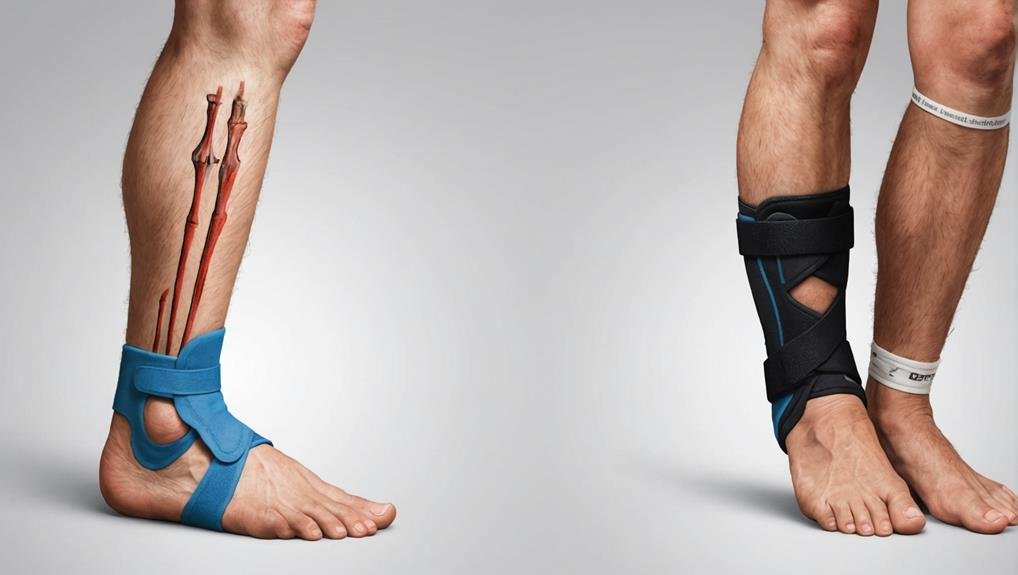When you think about injuries, it’s essential to understand the distinction between acute and chronic types. Acute injuries happen suddenly, often from direct trauma, resulting in immediate symptoms like pain and swelling. Imagine twisting your ankle or getting a deep cut—these are acute scenarios. On the flip side, chronic injuries sneak up over time, usually due to repetitive stress or poor technique, leading to persistent conditions like tennis elbow. While acute injuries demand immediate attention, chronic ones require ongoing management. But how do you effectively treat and prevent both? Let’s explore the nuances and strategies involved.
Key Takeaways
- Acute injuries occur suddenly from trauma, while chronic injuries develop gradually due to repetitive stress.
- Acute injuries present immediate, intense pain and swelling, whereas chronic injuries show gradual symptoms.
- Examples of acute injuries include fractures and dislocations, while chronic injuries include stress fractures and tennis elbow.
- Acute injuries typically heal within 2-4 weeks, whereas chronic injuries may take 6-12 weeks.
- Prevention of both types involves proper technique, adequate preparation, and appropriate protective gear.
Defining Acute Injuries
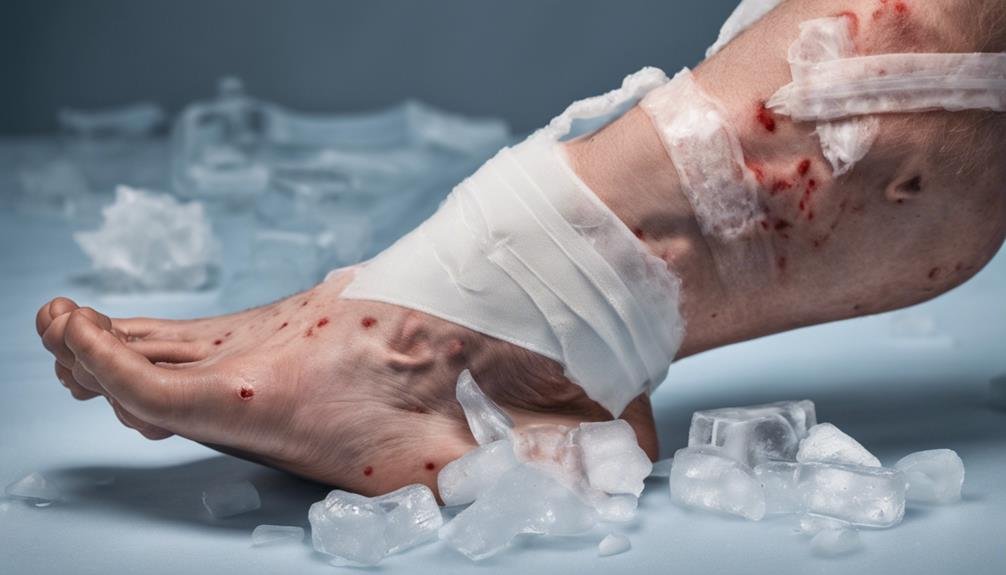
Acute injuries are sudden-onset injuries that typically result from trauma or accidents. Imagine you’re playing your favorite sport and suddenly twist your ankle. The intense pain, immediate swelling, and inability to move easily are classic signs of an acute injury. These injuries often include fractures, muscle tears, dislocations, and bruises. Although less common than chronic injuries, acute injuries can have a significant short-term impact on your daily life and activities.
When you experience an acute injury, focusing on immediate treatment is essential to prevent further damage and speed up your recovery. For instance, immobilizing the area and seeking medical attention is crucial if you suspect a fracture. Delaying treatment could worsen the injury and prolong healing time. Recognizing the severity of the trauma and acting promptly ensures the best chance for a swift recovery.
Acute injuries can be challenging, but understanding their nature and the importance of immediate treatment can alleviate some of the stress. You can minimize complications by immediately addressing the injury and returning to your routine as soon as possible. Remember, immediate attention is key to managing acute injuries effectively.
Understanding Chronic Injuries
While acute injuries strike quickly, chronic injuries creep up gradually due to repetitive stress or poor technique. These chronic injuries involve prolonged, repetitive motions that wear down your body over time. For instance, stress fractures, tennis elbow, shin splints, and runner’s knee are common culprits. They develop over longer periods, often unnoticed until the symptoms—like pain during activity, swelling, or a dull ache at rest—become apparent.
Managing these injuries effectively requires a proactive approach. You can’t just ignore them and hope they’ll go away. Instead, it’s essential to address the underlying causes and manage symptoms. Medication and physical therapy play significant roles in this process.
Physiotherapy for chronic injuries focuses on gentle stretching and strengthening exercises to improve your form and prevent further damage. Working with a professional can teach you strategies to modify your routine, reducing stress in the affected areas.
Prevention is also key. Paying attention to your body’s signals, using proper technique, and allowing adequate recovery time can help you avoid these injuries. Chronic injuries don’t have to sideline you permanently, but they demand consistent and mindful management.
Onset and Causes
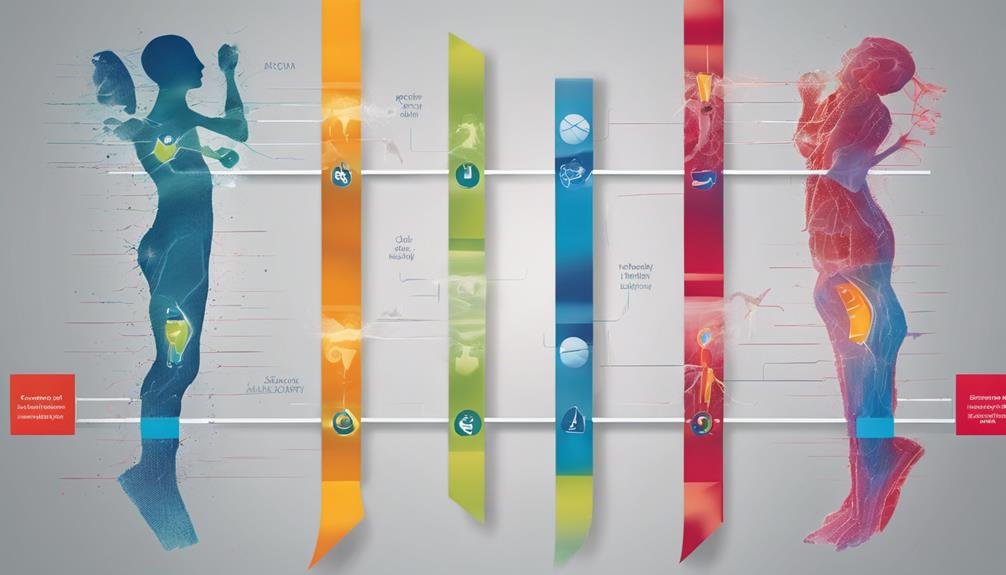
In the domain of injuries, timing and triggers play a vital role in their classification. Acute vs chronic injuries differ primarily in their onset and causes. Acute injuries hit suddenly, often catching you off guard due to accidents or trauma. Imagine spraining an ankle during a soccer game—that’s acute. On the other hand, chronic injuries sneak up over time, the result of repetitive motions or overuse. Think of a runner’s persistent knee pain from countless miles on the track. Understanding these differences helps you prevent and manage injuries effectively.
Here’s a clearer look at the onset and causes:
| Injury Type | Onset and Causes |
|---|---|
| Acute | Sudden onset: caused by sudden impacts or forces |
| Chronic | Gradual onset: due to repetitive motions, overuse |
| Acute | Often occurs during sports activities |
| Chronic | Common in long-term physical activities |
Acute injuries result from forces beyond your body’s capacity. Picture a harsh tackle in football—the sudden impact causes immediate damage. Conversely, chronic injuries stem from prolonged stress on tissues. Over time, this leads to gradual wear and tear, resulting in discomfort or pain. Recognizing these patterns is essential for addressing and preventing further injury.
Common Acute Injury Types
When you experience an acute injury, it usually happens suddenly, often due to a fall, collision, or unexpected twist. You might notice immediate pain and symptoms like swelling or a restricted range of motion. Common examples include muscle tears, fractures, sprains, and even more severe cases like concussions or dislocated joints, all of which need quick attention to minimize further harm.
Sudden Injury Occurrence
Imagine you’re engaged in a routine activity, and suddenly, an unexpected twist or impact causes sharp pain. This is how acute injuries happen—a sudden injury occurrence linked with trauma or accidents. Whether it’s a misstep while running, a fall during a game, or a collision on the road, these incidents can result in severe and immediate physical limitations.
Common acute injuries you might encounter include:
- Muscle Tears: A sudden jerk or overstretching can cause muscles to tear, leading to intense pain and weakness.
- Bone Fractures: A fall or direct blow can break bones, causing immediate and severe pain.
- Bruises: Often resulting from a direct impact, bruises can be painful and visible reminders of the trauma.
- Dislocations: When a joint is forced out of its normal position, it can be both painful and distressing.
While less common than chronic, these acute injuries have a significant short-term impact on your life. Prompt and appropriate treatment is essential to manage these injuries effectively and get you back on your feet. Please don’t underestimate the importance of addressing an acute injury as soon as it occurs to minimize complications.
Immediate Pain Symptoms
Although acute injuries occur suddenly, their immediate pain symptoms are unmistakable and demand prompt attention. When you experience an acute injury, you’ll likely feel severe pain right away. This intense pain can be accompanied by swelling, tenderness, and bruising, making it clear that something’s wrong.
For instance, if you suffer from a muscle tear or bone fracture, the severe pain can be so overwhelming that it immobilizes you. You might find it difficult to bear weight on the injured limb, a telltale sign of a significant problem.
Joint immobility is another common symptom of acute injuries, especially those involving dislocations or sprains. You might notice that your joint can’t move as it normally would, or you might see a visible deformity where the injury occurred. This lack of mobility can further emphasize the seriousness of the situation and highlight the need for immediate medical intervention.
Ignoring these symptoms isn’t an option; addressing them swiftly is vital for recovery. Remember, severe pain, swelling, and joint immobility aren’t just symptoms—they are signals that your body needs urgent care. Don’t hesitate to seek professional help.
Common Acute Examples
Experiencing immediate and intense pain often signals an acute injury, and understanding common types can help you identify them quickly. Acute injuries usually happen suddenly, often due to accidents or impacts during physical activities. Knowing some typical examples can prepare you for swift action if you encounter one.
- Sprains occur when ligaments, the tissues connecting bones, are stretched or torn. You might feel a sharp pain, followed by swelling and bruising, often in the ankle or wrist.
- Strains: When muscles or tendons are overstretched or torn, strains happen. This injury often results in severe discomfort, muscle spasms, and limited movement, commonly affecting your back or hamstrings.
- Contusions: More commonly known as bruises, contusions result from a direct blow or impact, leading to painful discoloration and swelling. They can affect any part of the body and often cause significant tenderness.
- Dislocations occur when bones are forced out of their normal position, usually in the shoulder, knee, or fingers, causing visible deformity and intense pain.
Prompt medical attention is essential for diagnosing and treating these injuries. Quick care can prevent complications and promote faster recovery. Don’t wait; seek help if you suspect an acute injury.
Common Chronic Injury Types
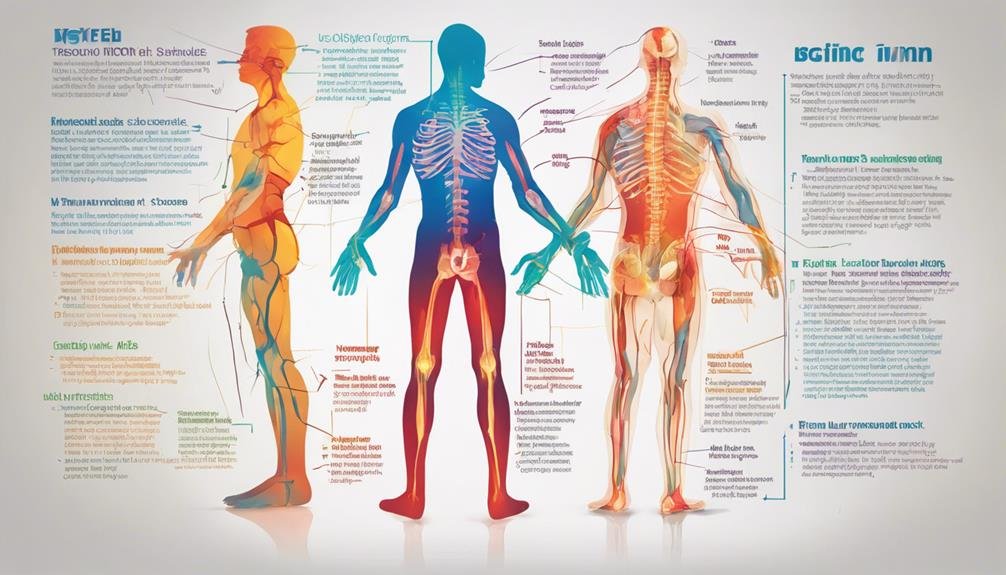
You’ll often find that chronic injuries stem from repetitive movements or poor technique in your activities.
Common overuse injuries like stress fractures, tennis elbow, and a runner’s knee can creep up on you, causing persistent pain and discomfort.
Understanding the causes, such as overuse or improper form, is key to preventing these long-term issues.
Common Overuse Injuries
Several common overuse injuries, which are a type of chronic injury, can greatly impact your physical activities. These injuries, like stress fractures, develop gradually over time due to repetitive stress on the affected area. Imagine the frustration when you can’t enjoy your favorite activities because of persistent pain.
Overuse injuries such as tendonitis, shin splints, and runner’s knee often result from improper training techniques, overtraining, or not giving the body enough rest.
Symptoms of these chronic injuries are hard to ignore:
- Persistent Pain: It nags at you, day after day, making even simple movements uncomfortable.
- Swelling and Tenderness: The affected area feels swollen and tender, a constant reminder of your body’s limits.
- Reduced Range of Motion: You can’t move like you used to, and it’s disheartening.
- Increased Frustration: Each step or activity reminds you of what you can’t do, not what you can.
Proper diagnosis and management are essential. Ignoring these signs can lead to further damage, making recovery even more challenging. Paying attention to your body’s signals and seeking help early can make all the difference in regaining your active lifestyle.
Causes of Chronic Injuries
Chronic injuries often creep up on you, arising from consistent, repetitive motion, poor technique, or overuse of specific muscles or joints. These injuries develop gradually, making it easy to overlook early symptoms.
Common chronic injury types include stress fractures, tennis elbow, shin splints, runner’s knee, and plantar fasciitis. These injuries often occur because of overtraining, where the body doesn’t get enough time to recover between workouts. This overuse can lead to persistent pain during activity, swelling, stiffness, and a decreased range of motion.
Improper footwear is another culprit, as it can negatively impact your gait and exert undue stress on certain body areas. Muscle imbalances and inadequate recovery are also significant causes, as they can lead to improper force distribution across your joints and muscles, resulting in chronic injuries over time.
Addressing the underlying causes of chronic injuries is essential to preventing and managing them. This might involve strengthening weak muscles, improving flexibility, or correcting biomechanical issues. By understanding the causes of chronic injuries and taking proactive steps, you can minimize their impact and maintain your physical health and performance.
Symptoms to Watch For
Recognizing the symptoms is essential for effective management when identifying injuries. Acute and chronic injuries reveal themselves differently, and knowing what to look for can make a significant difference in handling them. Acute injuries, often resulting from sudden trauma, present with immediate, severe pain. You might notice swelling and limited joint mobility. These symptoms appear quickly, usually within two weeks.
On the other hand, chronic injuries develop gradually due to prolonged, repetitive motion. They often start as a dull ache during activity but can lead to persistent discomfort even at rest. Swelling is a common symptom but not as intense as acute injuries. Chronic injuries may feel less disabling initially, but their persistent nature can be deceptive.
To better recognize and respond to these injuries, keep an eye out for these symptoms:
- Sudden severe pain – often indicates an acute injury.
- Dull ache during activity – a sign of chronic injury.
- Swelling is present in both but varies in intensity.
- Persistent discomfort at rest – a hallmark of chronic injuries.
Treatment Approaches
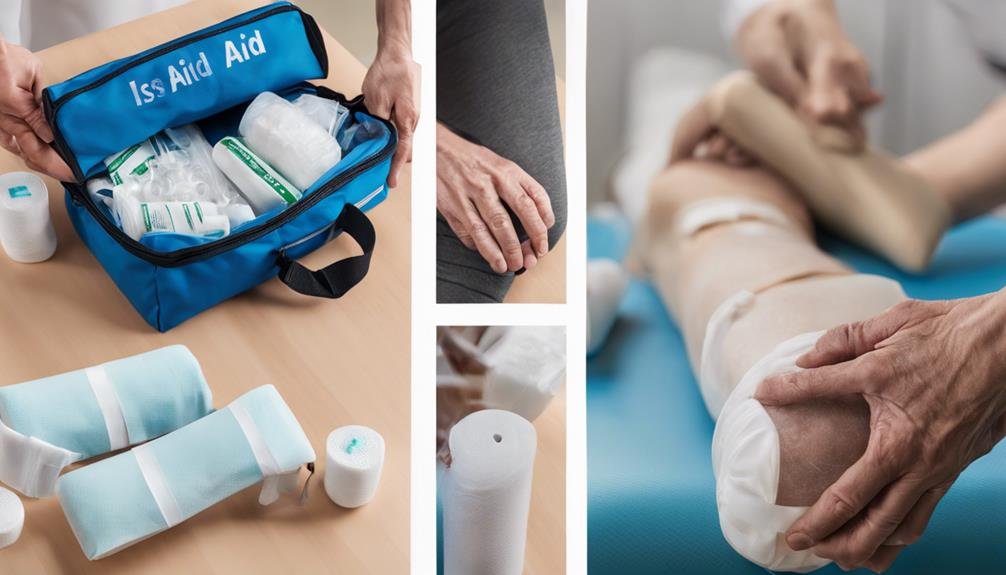
When dealing with an acute injury, starting with the R.I.C.E. method—rest, ice, compression, and elevation—can help reduce swelling and pain.
Physiotherapy techniques, such as targeted exercises and manual therapy, are essential to restoring function for acute and chronic injuries.
Don’t forget that medications can also aid in managing pain and inflammation, making recovery smoother.
R.I.C.E Method Explained
Have you ever wondered how to manage acute injuries like sprains or strains effectively? The R.I.C.E.E method is your go-to strategy. This tried-and-true approach is essential for treating acute injuries and invoR.I.C.E.ur important steps:
- Rest: Give the injured area time to heal by avoiding activities that could worsen the damage. Rest is vital to prevent further injury and ensure proper recovery.
- Ice: Apply ice packs to the affected area to reduce pain and swelling. This should be done in the early stages of the injury to minimize inflammation. Remember, ice is your best ally in the first 48 hours.
- Compress: Use an elastic bandage to wrap the injury snugly. Compression helps control swelling and provides the necessary support. Just make sure it’s not too snug to avoid cutting off circulation.
- Elevate: Keep the injured limb elevated above your heart level. This position promotes fluid drainage and reduces swelling. Prop it up with pillows, and let gravity assist in your healing process.
The R.I.C.E method is often recommended for managing injuries like sprains, strains, and bruises. By following these steps, you can speed up your recovery and get back to your routine quickly.
Physiotherapy Techniques
Physiotherapy techniques are essential tools in the management of both acute and chronic injuries, focusing on restoring mobility and strength. When dealing with physiotherapy for acute injuries, you’ll typically begin with passive therapies like manual therapy. These help set the stage for recovery before moving on to active exercises to rebuild strength and flexibility. Sometimes, initial treatments like setting broken bones are necessary before you can engage in these rehabilitation exercises. The goal is to address the acute damage quickly and effectively to prevent long-term issues.
The approach shifts slightly for chronic injuries. Treatments for chronic injuries often involve a combination of passive therapies such as hot/cold therapy and shockwave therapy. These help manage pain and improve circulation. Prescribed exercises play an essential role in restoring function and enhancing overall health. It’s crucial to have an individualized physiotherapy plan that addresses your specific needs. This way, you can maximize recovery and minimize the risk of future injuries.
Physiotherapy offers significant benefits whether you’re dealing with acute or chronic injuries. Focusing on targeted treatments can regain your form, strength, and confidence, paving the way for a healthier, more active lifestyle.
Medication and Recovery
Addressing injuries effectively requires a thorough approach that goes beyond physiotherapy techniques. While physical therapy is crucial for improving strength, flexibility, and range of motion, medication and recovery strategies are equally essential in your healing journey. It’s vital to use medication like pain relievers, anti-inflammatories, or muscle relaxants to manage symptoms and promote healing. When you combine these with rest and a gradual return to activity, you create a complete plan aiming for efficient recovery.
Here’s why a well-rounded approach is necessary for overcoming injuries:
- Pain Relief: Medication helps alleviate discomfort, allowing you to focus on rehabilitation without constant pain distractions.
- Inflammation Reduction: Anti-inflammatories can decrease swelling, helping tissues heal faster and reducing the risk of further damage.
- Enhanced Mobility: Physical therapy uses medication to restore movement and prevent stiffness in injured areas.
- Preventing Long-Term Complications: A balanced recovery plan minimizes the chance of chronic issues developing from acute injuries.
Recovery Timeframes
Recovery timeframes for injuries can vary greatly depending on whether acute or chronic. Acute injuries, like muscle strains, typically heal faster, often within 2-4 weeks. In contrast, chronic injuries, such as ligament or tendon damage, may require more patience, taking 6-12 weeks to recover fully. The recovery time differs due to the nature of the injury and how it impacts the body. A well-structured treatment and exercise plan is crucial for both types of injuries to speed up recovery.
Recovery times for surgical interventions can fluctuate based on the complexity of the procedure, whether it’s addressing an acute or chronic injury. To shorten your recovery period, it’s important to adhere to your healthcare provider’s prescribed treatment guidelines. These might include rest, medication, or rehabilitation exercises tailored to your situation.
Physiotherapy plays a significant role in the recovery process. Physiotherapy sessions can help manage pain, restore function, and prevent further injury. A professional’s individualized treatment plan ensures you address your unique needs and progress steadily. Your commitment to following these plans directly influences how swiftly you return to normal activities.
Prevention Strategies

Prevention is key to avoiding acute and chronic injuries. Employing effective prevention strategies can save you a lot of pain and downtime.
First, make sure to use the appropriate gear for your activity. It’s not just about looking the part; the right equipment protects you from potential harm.
Second, always include warm-up and cool-down routines in your exercise regimen. These steps help prepare your muscles and joints, reducing the risk of injury from sudden movements.
Avoiding overexertion is also essential. Pushing yourself too hard can lead to overuse injuries that sneak up over time. Muscle fatigue is another common culprit. When your muscles lack strength or endurance, they become more susceptible to damage.
To combat this, incorporate strength-building and endurance-focused exercises into your routine.
Consider these four steps to reduce your injury risk:
- Use appropriate gear to protect yourself.
- Warm-up and cool down to prepare your body.
- Avoid overexertion to prevent overuse injuries.
- Build muscle strength to fight fatigue.
Role of Physiotherapy
Physiotherapy plays a pivotal role in managing both sudden and long-lasting injuries by focusing on restoring mobility, strength, and function. When you face a sudden injury, such as a sprain or fracture, physiotherapy steps in after initial treatments like setting bones or surgeries. The goal is to restore your function and mobility efficiently. For long-lasting injuries, physiotherapy is vital for sustained healing. It combines passive therapies like manual therapy and acupuncture with active treatments, such as prescribed exercises, to enhance healing.
Here’s a breakdown of physiotherapy’s approach:
| Aspect | Sudden Injuries | Long-lasting Injuries |
|---|---|---|
| Immediate Focus | Restore function post-initial treatment | Sustained healing and prevention |
| Therapies Used | Passive (manual therapy) and active (exercises) | Passive, exercises, and injury prevention education |
| Outcome | Quick recovery of mobility and strength | Improved strength, flexibility, movement patterns |
Physiotherapy doesn’t just focus on treating injuries. It helps build strength, flexibility, and proper movement patterns, aiding your healing process. For long-lasting conditions, education on injury prevention is essential to prevent future issues. Whether you’re dealing with a sudden or long-lasting injury, physiotherapy provides a complete approach to recovery and prevention.
Conclusion
In understanding the difference between acute and chronic injuries, remember that acute injuries happen suddenly, often due to accidents, while chronic injuries develop over time from repetitive stress. Immediate treatment is essential for acute injuries, while chronic conditions benefit from proactive management and physiotherapy. Recovery times will vary, but prevention strategies can help minimize risks. Stay informed and consult professionals to effectively address both types of injuries, ensuring a quicker and safer return to your activities.
FAQs
What is the difference between acute and chronic injuries?
Acute injuries happen suddenly due to trauma, such asF.A.Q.sains, fractures, or cuts, often resulting from accidents or physical impact. Chronic injuries, on the other hand, develop over time due to repetitive stress or overuse, such as tendonitis or shin splints. Acute injuries are typically short-term and require immediate treatment, while chronic injuries persist longer.
Key Points:
- Acute injuries: Sudden, caused by trauma (e.g., fractures, sprains)
- Chronic injuries: Develop over time from repetitive stress (e.g., tendonitis)
- Acute: Immediate onset; Chronic: Long-term development
How do symptoms differ between acute and chronic injuries?
Acute injuries often cause immediate pain, swelling, bruising, and an inability to move the affected area. Chronic injuries usually present as dull, ongoing pain, stiffness, or discomfort that worsens with continued activity. While acute injuries need urgent care, chronic injuries may require long-term management like physical therapy.
Key Points:
- Acute injuries: Immediate pain, swelling, bruising
- Chronic injuries: Gradual pain, stiffness, worsens with activity
- Acute: Needs urgent care; Chronic: Long-term management
How are acute and chronic injuries treated?
Acute injuries typically require rest, ice, compression, elevation (R.I.C.E.), and possible medical intervention, such as surgery or immobilization. Chronic injuries often benefit from physical therapy exercises. In both cases, seeking medical advice is essential for proper treatment.
Key Points:
- Acute: R.I.C.E., surgery, immobilization
- Chronic: Rest, physical therapy, strengthening exercises
- Medical consultation is important for both types
